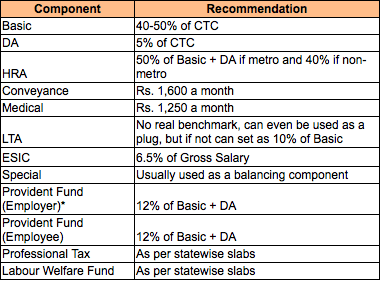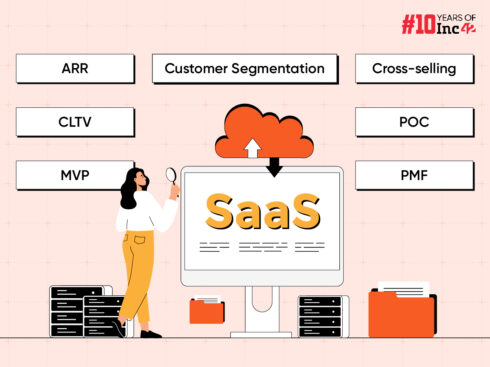
Although salaries are part and parcel of any business, often employers aren’t aware of the technicalities involved. While it may not seem important to some, structuring salaries correctly, reduces your liability as an employer as well as an employee.
For instance, allotting a large portion of the salary to the “Basic” component means your liability towards provident fund or ESIC contributions are also going to be higher. For startups, getting this right in the early stages could save you the trouble later.
Objectives of the perfect salary structure
While creating the ideal salary structures, there are three things you should keep in mind
- It should be tax efficient: This means that it should give employees the opportunity to save as much tax as possible. Salary amounts should be divided into components giving the employee the opportunity to avail as much tax deduction as possible.
- Reduce the employer’s liability: The salary structure should reduce the liability of the employer. The employer’s contribution to PF, Gratuity etc. should be kept as low as possible.
- It should be compliant: Compliance norms like minimum wages and PF laws should be kept in mind while drafting the salary structure.
A deeper look into each component
Let’s take a deeper look into the various components that make a salary. What do they mean and how are they calculated?
Basic Salary + Dearness allowance
The Basic component is the primary component and the core of the salary structure. It is usually the largest component of the CTC making up for 40-45% of the total CTC. The basic plays an important role in defining the salary as other components like Provident Fund, Gratuity and ESIC are dependent on it.
Dearness Allowance (DA) was introduced as part of the salary as a means to reduce the burden of inflation on salaried employees. This amount is usually set to about 5% of the total CTC and like the Basic component it also has an effect on PF, ESIC etc.
You should keep the following in mind while setting the amounts for Basic and DA:
- If it’s too high, it will increase the tax liability of the employee since this component is fully taxable. It also affects the liability of the employer since higher contributions would be required for PF, ESIC etc.
- If it’s too low, then you may not be able to meet the minimum wage norms set by the respective state government. Since minimum wages are updated regularly, you would run the risk of falling below the recommended wage limit.
House Rent Allowance (HRA)
The House Rent Allowance, as the name suggests is a component that employees can leverage if they are living in rented accommodations. The amount that you can claim as tax deduction under HRA cannot be more than 50% of your basic in a metro or 40% of your basic in a non-metro. Hence, depending on where your workplace is located, this salary component will usually be set at 40% or 50% of the basic salary.
Leave travel allowance (LTA)
Leave travel allowance (LTA) remunerates employees for their travel within the country. This component is widely used by employers due to the tax benefits associated with it. An employee can claim tax benefits for the fare expenses paid for his/her family when they take a holiday. However, there are restrictions to what you can claim as tax benefits:
- Only fare expenses are covered: Only the travel fare expenses can be claimed. Stay and food on your trip aren’t covered.
- Travel must be within India: If you travel to a foreign country, the expenses aren’t tax deductible. Only travel within the country is covered.
- What counts as family: Immediate family that are mainly dependant on the employee are covered under LTA.
Conveyance Allowance
The conveyance component of the salary structure is paid to employees for their travel expenses between their homes and workplaces. The maximum amount that is tax deductible under this component is Rs. 1,600 a year or Rs. 19,200 a year. Hence, this is also the recommended limit that most organisations would use for conveyance allowance.
It’s also important to note that this component is only tax deductible if an organisation does not have its own means of transport for employees. If the organisation has made arrangements to ferry employees to and from work, then conveyance allowance cannot be claimed for tax benefits.
Medical Allowance
Medical allowance is paid as a reimbursement for medical expenses borne by employees. This amount is tax deductible up to Rs. 15,000 a year or Rs. 1,250 every month. In order to claim tax benefits under this component, employees need to submit proof of their medical expenses.
In case the Rs. 1,250 isn’t claimed in one month, then this amount is carried forward to the next month. This means that a cumulative amount of Rs. 15,000 can be claimed at the end of the year. This is also the recommended amount that organisations usually allot to this component of the salary structure.
Child Education Allowance
This component is paid out towards tuition fees of employees’ children and is tax deductible up to Rs. 100 every month for a maximum of two children. Hence, this amount is usually set to not more than Rs. 2,400 a year for an employee.
Special Allowance
Special allowance is the balancing component of the salary structure. It is usually used by organisation as the leftover of the CTC when the rest of the components have been paid out. This component is fully taxable and is also taken into account for the calculation of Provident Fund.
Deductions
Deductions are elements of the salary that are part of the CTC but are deducted from the in-hand salary that employees receive. Let’s take a deeper look at some of the most common salary deductions and what they mean.
Provident Fund
Provident Fund (PF) is calculated at 12% of Basic + DA + Special Allowance. The employer and the employee both make an equal contribution of 12% each. This is applicable to companies who have 20 or more employees on their payroll. If an employee’s Basic + DA + Special Allowance are less than Rs. 15,000 then it is mandatory for Provident Fund to be deducted. Other employees can opt out by filling form 11 or can choose to have PF deducted on the ceiling of Rs. 15,000 which would be Rs. 1,800 monthly.
You can find all the information you need about Provident Fund in our in-depth article.
Employees State Insurance Corporation (ESIC)
Deductions towards ESIC are mandatory for employees whose gross salary is not more than Rs. 15,000. It is only applicable in companies where there are 20 or more employees within the Rs. 15,000 gross salary bracket. Employees have to make a contribution of 1.75% of the gross salary and employers have to make a contribution of 4.75% of the gross salary.
Professional Tax
Professional tax is the tax levied by Governments of certain states on salaried employees. The states where professional tax is applicable are Karnataka, Bihar, West Bengal, Andhra Pradesh, Telangana, Maharashtra, Tamil Nadu, Gujarat, Assam, Chhattisgarh, Kerala, Meghalaya, Odisha, Tripura, Madhya Pradesh, and Sikkim.
The amount of profession Tax that is deducted varies from state to state where they are applicable.
Labour Welfare Fund
Labour Welfare Fund, as the name suggests, is a contribution made by salaried employees for the benefit of the labour class. This contribution is applicable in the states of Karnataka, West Bengal, Maharashtra, Andhra Pradesh, Kerala, Goa, Delhi, Punjab, and Haryana & Madhya Pradesh.
The contribution amount varies from state to state and is relatively small. The employer and the employee both make contributions and the employer pays approximately twice the employee contribution. The payments are made semi-annually in the months of June and December.
Like Professional Tax, Labour Welfare Fund contributions also vary from state to state where they are applicable.
What’s the ideal salary structure?
So what’s the best way to draft salary structures? To answer this, we’ve put together a table of the common components that make up a salary. We’ve also added recommended amounts to each component that should assist you in drafting an ideal salary structure.

*Note 1: The PF Employer Contribution also bears additional administrative charges
Note 2: Feel free to use components like Child Hostel and Child Education; since they are small, we have ignored in our structure.



























